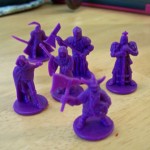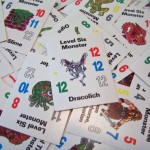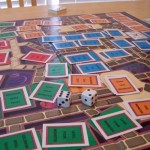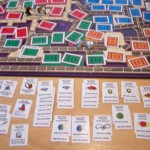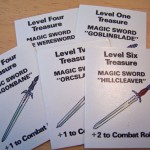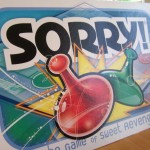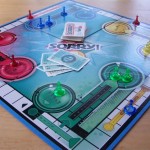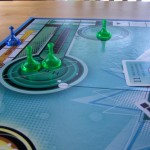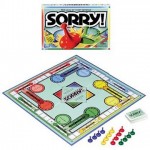 Dungeon!, originally released by TSR, simulates some of the aspects of Dungeons & Dragons. You play a character and roam through a dungeon killing monsters for treasure. It came out in 1975, a year after D&D, and has been revised several times. There is yet another version coming out in October, but the copy I own is the 1989 version called “New Dungeon” because it revamped the classes.
Dungeon!, originally released by TSR, simulates some of the aspects of Dungeons & Dragons. You play a character and roam through a dungeon killing monsters for treasure. It came out in 1975, a year after D&D, and has been revised several times. There is yet another version coming out in October, but the copy I own is the 1989 version called “New Dungeon” because it revamped the classes.

In the basic version we play first, everyone is a warrior. (Wife: I want to be the female.) Fine, I’ll be… uh.. the dwarf, I guess. They both look like dwarves, which is funny because Dwarf is one of the advanced classes. Whatever. Warriors get to move up to 5 spaces each turn. (Wife: We don’t roll?) Not according to the box rules, but there are house rules where you roll to move. (Wife: Then what are the dice for?) I’ll get to that. Back to the moving. You can go up to 5 spaces, but if you enter a room you have to stop and fight and end your turn, even if it’s less than 5 spaces. If you want to go through a secret door, the dashed lines (Wife: I was just about to ask that.), you have to roll a die. Warriors open secret doors on a 1 or a 2. If you fail, your turn ends. If you fail three times, on the fourth you automatically find the secret door and can go through it. (Wife: That’s nice.) Yeah, a reward for just wasting three entire turns doing nothing.
When it comes to combat, monster cards have six numbers on them, and warriors use the red one. You roll both dice and try to get equal to or higher than the number. (Wife: What are the other numbers for?) The other classes and spells. If you beat a monster in a room, you get a treasure of the appropriate level. If you beat a monster in a chamber, you get no treasure. (Wife: Poor chamber monsters.) The board is laid out with rooms of six different levels of difficulty, with the higher levels getting the best treasures.
There are special treasures too. Secret Door cards let you walk through secret doors without rolling. ESP Medallions let you see monsters before you decide to fight them. Crystal Balls let you look at the monster and treasure of any room on the board. And Magic Swords give you a bonus to fighting. (Wife: How much?) There are four +1 swords and one +2 sword. (Wife: Do they stack?) No.
Under the basic rules, warriors need 30,000 gold worth of treasure to win. You have to adventure out, defeat monsters, collect treasures and return to the Main Staircase. First one to do that wins. When you play with more people, you get in each other’s way a lot, which drags out the game. With just two of us, she runs for the level 1 rooms and I head for level 4. (Wife: What?) See, I’ve played this game before (Wife: Cheater!) and I know that while it’s easy to fight level 1 and 2 monsters, many of whom need a 3 or even a 2 – you can’t roll less than 2 on two dice – to defeat, there is a disproportionate jump in difficulty from level 4 to level 5 in that level 5 is much harder than level 4, and level 4 is still statistically favorable to win while earning more valuable treasures. (Wife: Cheater! Cheater!) I know. I take a pretty quick lead, but I forgot two things. First, getting a secret door card is much easier in the lower level rooms, as is a magic sword. Second, if you go down the wrong hall to level 4, you end up having to detour through level 5 or take the long way around. (Wife: You went the wrong way?) I went the wrong way.
So, she racks up a pile of treasure, with Secret Door cards and magic swords, and while I have a pile of money I step into a level 5 room that’s too difficult. According to the rules, when you don’t kill a monster on the first attack, another player rolls for the monster and then you consult the damage table to see what the monster does to you. The results range from the monster missing and nothing happening, to dropping treasure, to being killed. (Wife: Are you dead?) She rolls a 3, so I’m not dead, but I have to drop half of my treasure and return to the Main Staircase. She’s now winning. (Wife: I’m winning!) And basically I’m screwed. My choices are to either go back to where I lost and try to reclaim my treasure and hope the next couple rooms give me enough to win, or take the loss and head for the easier rooms. The problem with the second option is that she’s been clearing out, and will continue to clear out, those rooms, so it’s a long wasted run to finally get something worthwhile. I decide to go get my stuff. (Wife: Revenge!) Revenge!
She wins. (Wife: I win!)
Having played out the basic game rather quickly, I propose we play again. Advanced this time. (Wife: You are just trying to steal my victory.) No, really, we should just play another variant. (Wife: Advanced is too complicated.) You could play a warrior again. (Wife: And you would play what?) A wizard. (Wife: Why?) Just to be different. (Wife: No, really, why?) I like wizards. (Wife: I’m not playing if you don’t tell me.) I put on my robe and hat. (Wife: Just tell me!) Fine! Because with spells you can defeat level 6 monsters really easy. (Wife: Cheater!) Whatever. We’ll both play warriors again, but we’ll clear the dungeon entirely and the winner is the one with the most treasure at the end. (Wife: Better.)
I’m not going to bore you with the details, because it was a very long game, but she won. (Wife: I win!) I avoided my earlier mistakes, but I just lost out on luck. She ended the game with literally all the Magic Swords (Wife: That don’t stack! Lame!) and most of the other special treasure cards. I didn’t get a Secret Door card until we were pushing into level 5. I also want to avoid the details because this game got really ugly. Remember that rule about having another player roll for the monsters? I recommend instead allowing the player to roll for their own damage. It’ll prevent players from being angry at other players and instead be angry at the dice. Nothing makes you hate another player quite as much as them rolling a 2 and you having to drop ALL your treasure and return to the Main Staircase. (Wife: Yeah! Screw that!) Honestly, we could have played the game a little more cutthroat, but tended to let the other get their own treasure back rather than go steal it after it was dropped.
I’m curious if the new version coming out this fall will have better or different rules. No matter what, if we ever play this again (Wife: Never!) it will be after a bunch of research on house rules that help the game be more fun.
Despite my lack of winning, I still like Dungeon! Though I fully admit that part of it is nostalgia. Back in the day (Wife: Here we go…) some of my gaming groups would use the board and modified rules along with real D&D characters. It was easier than drawing out a random dungeon map. We would just toss down the board, pick a chamber to be the entrance and start exploring. In my opinion, the game is worth owning for that alone.
Anyway…
Man, 0. Wife, 7.
(Wife: I…) Just don’t.
